Rorschach test
| Rorschach test | ||||||||||||||
|---|---|---|---|---|---|---|---|---|---|---|---|---|---|---|
| Medical diagnostics | ||||||||||||||
| ||||||||||||||
| Pronunciation | (/ˈrɔːrʃɑːk/ or /ˈrɔərʃɑːk/,[3] German pronunciation: [ˈʀoːɐ̯ʃax] | |||||||||||||
| Synonyms | Rorschach inkblot test, the Rorschach technique, inkblot test | |||||||||||||
| MeSH | D012392 | |||||||||||||
Although the Exner Scoring System (developed since the 1960s) claims to have addressed and often refuted many criticisms of the original testing system with an extensive body of research,[6] some researchers continue to raise questions. The areas of dispute include the objectivity of testers, inter-rater reliability, the verifiability and general validity of the test, bias of the test's pathology scales towards greater numbers of responses, the limited number of psychological conditions which it accurately diagnoses, the inability to replicate the test's norms, its use in court-ordered evaluations, and the proliferation of the ten inkblot images, potentially invalidating the test for those who have been exposed to them.[7]
History

Hermann Rorschach created the inkblot test in 1921.
It has been suggested that Rorschach's use of inkblots may have been inspired by German doctor Justinus Kerner who, in 1857, had published a popular book of poems, each of which was inspired by an accidental inkblot.[11] French psychologist Alfred Binet had also experimented with inkblots as a creativity test,[12] and, after the turn of the century, psychological experiments where inkblots were utilized multiplied, with aims such as studying imagination and consciousness.[13]
After studying 300 mental patients and 100 control subjects, in 1921 Rorschach wrote his book Psychodiagnostik, which was to form the basis of the inkblot test (after experimenting with several hundred inkblots, he selected a set of ten for their diagnostic value),[14] but he died the following year. Although he had served as Vice President of the Swiss Psychoanalytic Society, Rorschach had difficulty in publishing the book and it attracted little attention when it first appeared.[15]
In 1927, the newly founded Hans Huber publishing house purchased Rorschach's book Psychodiagnostik from the inventory of Ernst Bircher.[16] Huber has remained the publisher of the test and related book, with Rorschach a registered trademark of Swiss publisher Verlag Hans Huber, Hogrefe AG.[17] The work has been described as "a densely written piece couched in dry, scientific terminology".[18]
After Rorschach's death, the original test scoring system was improved by Samuel Beck, Bruno Klopfer and others.[19] John E. Exner summarized some of these later developments in the comprehensive system, at the same time trying to make the scoring more statistically rigorous. Some systems are based on the psychoanalytic concept of object relations. The Exner system remains very popular in the United States, while in Europe other methods sometimes dominate,[20][21] such as that described in the textbook by Evald Bohm, which is closer to the original Rorschach system and rooted more deeply in the original psychoanalysis principles.[citation needed]
Rorschach never intended the inkblots to be used as a general personality test, but developed them as a tool for the diagnosis of schizophrenia. It was not until 1939 that the test was used as a projective test of personality, a use of which Rorschach had always been skeptical.[22] Interviewed in 2012 for a BBC Radio 4 documentary, Rita Signer, curator of the Rorschach Archives in Bern, Switzerland, suggested that far from being random or chance designs, each of the blots selected by Rorschach for his test had been meticulously designed to be as ambiguous and "conflicted" as possible.[23]
Method
The Rorschach test is appropriate for subjects from the age of five to adulthood. The administrator and subject typically sit next to each other at a table, with the administrator slightly behind the subject. Side-by-side seating of the examiner and the subject is used to reduce any effects of inadvertent cues from the examiner to the subject. In other words, side-by-side seating mitigates the possibility that the examiner will accidentally influence the subject's responses.[24] This is to facilitate a "relaxed but controlled atmosphere". There are ten official inkblots, each printed on a separate white card, approximately 18 by 24 cm in size.[25] Each of the blots has near perfect bilateral symmetry. Five inkblots are of black ink, two are of black and red ink and three are multicolored, on a white background.[26][27][28] After the test subject has seen and responded to all of the inkblots (free association phase), the tester then presents them again one at a time in a set sequence for the subject to study: the subject is asked to note where he sees what he originally saw and what makes it look like that (inquiry phase). The subject is usually asked to hold the cards and may rotate them. Whether the cards are rotated, and other related factors such as whether permission to rotate them is asked, may expose personality traits and normally contributes to the assessment.[29] As the subject is examining the inkblots, the psychologist writes down everything the subject says or does, no matter how trivial. Analysis of responses is recorded by the test administrator using a tabulation and scoring sheet and, if required, a separate location chart.[24]The general goal of the test is to provide data about cognition and personality variables such as motivations, response tendencies, cognitive operations, affectivity, and personal/interpersonal perceptions. The underlying assumption is that an individual will class external stimuli based on person-specific perceptual sets, and including needs, base motives, conflicts, and that this clustering process is representative of the process used in real-life situations.[30] Methods of interpretation differ. Rorschach scoring systems have been described as a system of pegs on which to hang one's knowledge of personality.[31] The most widely used method in the United States is based on the work of Exner.
Administration of the test to a group of subjects, by means of projected images, has also occasionally been performed, but mainly for research rather than diagnostic purposes.[24]
Test administration is not to be confused with test interpretation:
The interpretation of a Rorschach record is a complex process. It requires a wealth of knowledge concerning personality dynamics generally as well as considerable experience with the Rorschach method specifically. Proficiency as a Rorschach administrator can be gained within a few months. However, even those who are able and qualified to become Rorschach interpreters usually remain in a "learning stage" for a number of years.[24]
Features or categories
The interpretation of the Rorschach test is not based primarily on the contents of the response, i.e., what the individual sees in the inkblot (the content). In fact, the contents of the response are only a comparatively small portion of a broader cluster of variables that are used to interpret the Rorschach data: for instance, information is provided by the time taken before providing a response for a card can be significant (taking a long time can indicate "shock" on the card).[32] as well as by any comments the subject may make in addition to providing a direct response.[33]In particular, information about determinants (the aspects of the inkblots that triggered the response, such as form and color) and location (which details of the inkblots triggered the response) is often considered more important than content, although there is contrasting evidence.[34][35] "Popularity" and "originality" of responses[36] can also be considered as basic dimensions in the analysis.[37]
Content
The goal in coding content of the Rorschach is to categorize the objects that the subject describes in response to the inkblot. There are 27 established codes for identifying the name of the descriptive object. The codes are classified and include terms such as "human", "nature", "animal", "abstract", "clothing", "fire", and "x-ray", to name a few. Content described that does not have a code already established should be coded using the code "idiographic contents" with the shorthand code being "Idio." [38] Items are also coded for statistical popularity (or, conversely, originality).[39]More than any other feature in the test, content response can be controlled consciously by the subject, and may be elicited by very disparate factors, which makes it difficult to use content alone to draw any conclusions about the subject's personality; with certain individuals, content responses may potentially be interpreted directly, and some information can at times be obtained by analyzing thematic trends in the whole set of content responses (which is only feasible when several responses are available), but in general content cannot be analyzed outside of the context of the entire test record.[40]
Location
Identifying the location of the subject's response is another element scored in the Rorschach system. Location refers to how much of the inkblot was used to answer the question. Administrators score the response "W" if the whole inkblot was used to answer the question, "D" if a commonly described part of the blot was used, "Dd" if an uncommonly described or unusual detail was used, or "S" if the white space in the background was used. A score of W is typically associated with the subject's motivation to interact with his or her surrounding environment. D is interpreted as one having efficient or adequate functioning. A high frequency of responses coded Dd indicate some maladjustment within the individual. Responses coded S indicate an oppositional or uncooperative test subject.[25][38]Determinants
Systems for Rorschach scoring generally include a concept of "determinants": These are the factors that contribute to establishing the similarity between the inkblot and the subject's content response about it. They can also represent certain basic experiential-perceptual attitudes, showing aspects of the way a subject perceives the world. Rorschach's original work used only form, color and movement as determinants. However currently, another major determinant considered is shading,[41] which was inadvertently introduced by poor printing quality of the inkblots. Rorschach initially disregarded shading,[42] since the inkblots originally featured uniform saturation, but later recognized it as a significant factor.[43][44][45]Form is the most common determinant, and is related to intellectual processes. Color responses often provide direct insight into one's emotional life. Movement and shading have been considered more ambiguously, both in definition and interpretation. Rorschach considered movement only as the experiencing of actual motion, while others have widened the scope of this determinant, taking it to mean that the subject sees something "going on".[46]
More than one determinant can contribute to the formation of the subject's perception. Fusion of two determinants is taken into account, while also assessing which of the two constituted the primary contributor. For example, "form-color" implies a more refined control of impulse than "color-form". It is, indeed, from the relation and balance among determinants that personality can be most readily inferred.[46]
Symmetry of the test items
A striking characteristic of the Rorschach inkblots is their symmetry. Many unquestionably accept this aspect of the nature of the images but Rorschach, as well as other researchers, certainly did not. Rorschach experimented with both asymmetric and symmetric images before finally opting for the latter.[47]He gives this explanation for the decision:
Asymmetric figures are rejected by many subjects; symmetry supplied part of the necessary artistic composition. It has a disadvantage in that it tends to make answers somewhat stereotyped. On the other hand, symmetry makes conditions the same for right and left handed subjects; furthermore, it facilitates interpretation for certain blocked subjects. Finally, symmetry makes possible the interpretation of whole scenes.[48]The impact of symmetry in the Rorschach inkblot's has also been investigated further by other researchers.[47]
Exner scoring system
The Exner scoring system, also known as the Rorschach Comprehensive System (RCS),[49] is the standard method for interpreting the Rorschach test. It was developed in the 1960s by Dr. John E. Exner, as a more rigorous system of analysis. It has been extensively validated and shows high inter-rater reliability.[6][50] In 1969, Exner published The Rorschach Systems, a concise description of what would be later called "the Exner system". He later published a study in multiple volumes called The Rorschach: A Comprehensive system, the most accepted full description of his system.Creation of the new system was prompted by the realization that at least five related, but ultimately different methods were in common use at the time, with a sizeable minority of examiners not employing any recognized method at all, basing instead their judgment on subjective assessment, or arbitrarily mixing characteristics of the various standardized systems.[51]
The key components of the Exner system are the clusterization of Rorschach variables and a sequential search strategy to determine the order in which to analyze them,[52] framed in the context of standardized administration, objective, reliable coding and a representative normative database.[53] The system places a lot of emphasis on a cognitive triad of information processing, related to how the subject processes input data, cognitive mediation, referring to the way information is transformed and identified, and ideation.[54]
In the system, responses are scored with reference to their level of vagueness or synthesis of multiple images in the blot, the location of the response, which of a variety of determinants is used to produce the response (i.e., what makes the inkblot look like what it is said to resemble), the form quality of the response (to what extent a response is faithful to how the actual inkblot looks), the contents of the response (what the respondent actually sees in the blot), the degree of mental organizing activity that is involved in producing the response, and any illogical, incongruous, or incoherent aspects of responses. It has been reported that popular responses on the first card include bat, badge and coat of arms.[31]
Using the scores for these categories, the examiner then performs a series of calculations producing a structural summary of the test data. The results of the structural summary are interpreted using existing research data on personality characteristics that have been demonstrated to be associated with different kinds of responses.
With the Rorschach plates (the ten inkblots), the area of each blot which is distinguished by the client is noted and coded—typically as "commonly selected" or "uncommonly selected". There were many different methods for coding the areas of the blots. Exner settled upon the area coding system promoted by S. J. Beck (1944 and 1961). This system was in turn based upon Klopfer's (1942) work.
As pertains to response form, a concept of "form quality" was present from the earliest of Rorschach's works, as a subjective judgment of how well the form of the subject's response matched the inkblots (Rorschach would give a higher form score to more "original" yet good form responses), and this concept was followed by other methods, especially in Europe; in contrast, the Exner system solely defines "good form" as a matter of word occurrence frequency, reducing it to a measure of the subject's distance to the population average.[55]
Rorschach performance assessment system
Rorschach performance assessment system (R-PAS) is a scoring method created by several members of the Rorschach Research Council. They believed that the Exner scoring system was in need of an update, but after Exner's death, the Exner family forbade any changes to be made to the Comprehensive System.[56] Therefore, they established a new system: the R-PAS. It is an attempt at creating a current, empirically based, and internationally focused scoring system that is easier to use than Exner's Comprehensive System.[57] The R-PAS manual is intended to be a comprehensive tool for administering, scoring, and interpreting the Rorschach. The manual consists of two chapters that are basics of scoring and interpretation, aimed for use for novice Rorschach users, followed by numerous chapters containing more detailed and technical information.[58]In terms of updated scoring, the authors only selected variables that have been empirically supported in the literature. To note, the authors did not create new variables or indices to be coded, but systematically reviewed variables that had been used in past systems.[59] While all of these codes have been used in the past, many have been renamed to be more face valid and readily understood. Scoring of the indices has been updated (e.g. utilizing percentiles and standard scores) to make the Rorschach more in line with other popular personality measures.
In addition to providing coding guidelines to score examinee responses, the R-PAS provides a system to code an examinee's behavior during Rorschach administration. These behavioral codes are included as it is believed that the behaviors exhibited during testing are a reflection of someone's task performance and supplements the actual responses given. This allows generalizations to be made between someone's responses to the cards and their actual behavior.
The R-PAS also recognized that scoring on many of the Rorschach variables differed across countries.[59] Therefore, starting in 1997, Rorschach protocols from researchers around the world were compiled.[60] After compiling protocols for over a decade, a total of 15 adult samples were used to provide a normative basis for the R-PAS. The protocols represent data gathered in the United States, Europe, Israel, Argentina and Brazil.
Cultural differences
Comparing North American Exner normative data with data from European and South American subjects showed marked differences in some features, some of which impact important variables, while others (such as the average number of responses) coincide.[61] For instance, texture response is typically zero in European subjects (if interpreted as a need for closeness, in accordance with the system, a European would seem to express it only when it reaches the level of a craving for closeness),[62] and there are fewer "good form" responses, to the point where schizophrenia may be suspected if data were correlated to the North American norms.[63] Form is also often the only determinant expressed by European subjects;[64] while color is less frequent than in American subjects, color-form responses are comparatively frequent in opposition to form-color responses; since the latter tend to be interpreted as indicators of a defensive attitude in processing affect, this difference could stem from a higher value attributed to spontaneous expression of emotions.[62]The differences in form quality are attributable to purely cultural aspects: different cultures will exhibit different "common" objects (French subjects often identify a chameleon in card VIII, which is normally classed as an "unusual" response, as opposed to other animals like cats and dogs; in Scandinavia, "Christmas elves" (nisser) is a popular response for card II, and "musical instrument" on card VI is popular for Japanese people),[65] and different languages will exhibit semantic differences in naming the same object (the figure of card IV is often called a troll by Scandinavians and an ogre by French people).[66] Many of Exner's "popular" responses (those given by at least one third of the North American sample used) seem to be universally popular, as shown by samples in Europe, Japan and South America, while specifically card IX's "human" response, the crab or spider in card X and one of either the butterfly or the bat in card I appear to be characteristic of North America.[66][67]
Form quality, popular content responses and locations are the only coded variables in the Exner systems that are based on frequency of occurrence, and thus immediately subject to cultural influences; therefore, cultural-dependent interpretation of test data may not necessarily need to extend beyond these components.[68]
The cited language differences mean that it's imperative for the test to be administered in the subject's native language or a very well mastered second language, and, conversely, the examiner should master the language used in the test. Test responses should also not be translated into another language prior to analysis except possibly by a clinician mastering both languages. For example, a bow tie is a frequent response for the center detail of card III, but since the equivalent term in French translates to "butterfly tie", an examiner not appreciating this language nuance may code the response differently from what is expected.[69]
Inkblots
Below are the ten inkblots of the Rorschach test printed in Rorschach's Rorschach Test – Psychodiagnostic Plates,[70] together with the most frequent responses for either the whole image or the most prominent details according to various authors.| Card | Popular responses[71][72][73] | Comments[74][75] | ||||||
|---|---|---|---|---|---|---|---|---|
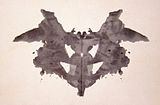 |
| When seeing card I, subjects often inquire on how they should proceed, and questions on what they are allowed to do with the card (e.g. turning it) are not very significant. Being the first card, it can provide clues about how subjects tackle a new and stressful task. It is not, however, a card that is usually difficult for the subject to handle, having readily available popular responses. | ||||||
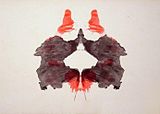 |
| The red details of card II are often seen as blood, and are the most distinctive features. Responses to them can provide indications about how a subject is likely to manage feelings of anger or physical harm. This card can induce a variety of sexual responses. | ||||||
 |
| Card III is typically perceived to contain two humans involved in some interaction, and may provide information about how the subject relates with other people (specifically, response latency may reveal struggling social interactions). | ||||||
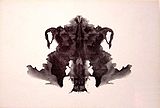 |
| Card IV is notable for its dark color and its shading (posing difficulties for depressed subjects), and is generally perceived as a big and sometimes threatening figure; compounded with the common impression of the subject being in an inferior position ("looking up") to it, this serves to elicit a sense of authority. The human or animal content seen in the card is almost invariably classified as male rather than female, and the qualities expressed by the subject may indicate attitudes toward men and authority. Because of this Card IV is often called "The Father Card".[76] | ||||||
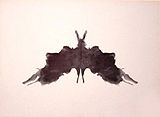 |
| Card V is an easily elaborated card that is not usually perceived as threatening, and typically instigates a "change of pace" in the test, after the previous more challenging cards. Containing few features that generate concerns or complicate the elaboration, it is the easiest blot to generate a good quality response about. | ||||||
 |
| Texture is the dominant characteristic of card VI, which often elicits association related to interpersonal closeness; it is specifically a "sex card", its likely sexual percepts being reported more frequently than in any other card, even though other cards have a greater variety of commonly seen sexual contents. | ||||||
 |
| Card VII can be associated with femininity (the human figures commonly seen in it being described as women or children), and function as a "mother card", where difficulties in responding may be related to concerns with the female figures in the subject's life. The center detail is relatively often (though not popularly) identified as a vagina, which makes this card also relate to feminine sexuality in particular. | ||||||
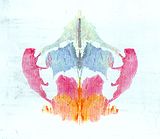 |
| People often express relief about card VIII, which lets them relax and respond effectively. Similar to card V, it represents a "change of pace"; however, the card introduces new elaboration difficulties, being complex and the first multi-colored card in the set. Therefore, people who find processing complex situations or emotional stimuli distressing or difficult may be uncomfortable with this card. | ||||||
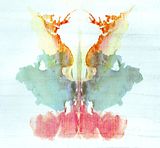 |
| Characteristic of card IX is indistinct form and diffuse, muted chromatic features, creating a general vagueness. There is only one popular response, and it is the least frequent of all cards. Having difficulty with processing this card may indicate trouble dealing with unstructured data, but aside from this there are few particular "pulls" typical of this card. | ||||||
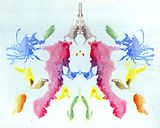 |
| Card X is structurally similar to card VIII, but its uncertainty and complexity are reminiscent of card IX: people who find it difficult to deal with many concurrent stimuli may not particularly like this otherwise pleasant card. Being the last card, it may provide an opportunity for the subject to "sign out" by indicating what they feel their situation is like, or what they desire to know. |
Prevalence
United States
The Rorschach test is used almost exclusively by psychologists. Forensic psychologists use the Rorschach 36% of the time.[77] In custody cases, 23% of psychologists use the Rorschach to examine a child.[78] Another survey found that 124 out of 161 (77%) of clinical psychologists engaging in assessment services utilize the Rorschach,[79] and 80% of psychology graduate programs teach its use.[80] Another study found that its use by clinical psychologists was only 43%, while it was used less than 24% of the time by school psychologists.[77]During World War II, United States Army Medical Corps chief psychiatrist Dr. Douglas Kelley and psychologist Gustave Gilbert administered the Rorschach test to the 22 defendants in the Nazi leadership group prior to the first Nuremberg trials.[81]
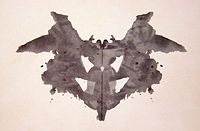
No comments:
Post a Comment